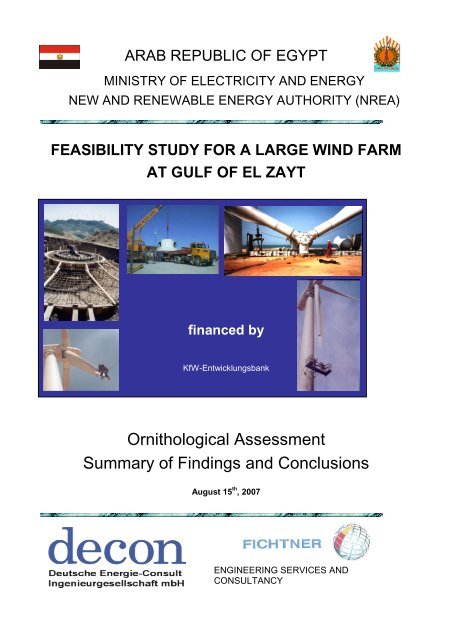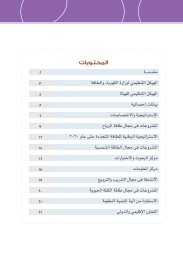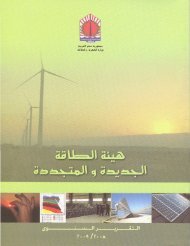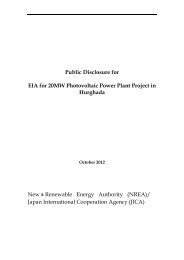FEASIBILITY STUDY FOR A LARGE WIND FARM AT GULF ... - NREA
FEASIBILITY STUDY FOR A LARGE WIND FARM AT GULF ... - NREA
FEASIBILITY STUDY FOR A LARGE WIND FARM AT GULF ... - NREA
You also want an ePaper? Increase the reach of your titles
YUMPU automatically turns print PDFs into web optimized ePapers that Google loves.
ARAB REPUBLIC OF EGYPT<br />
MINISTRY OF ELECTRICITY AND ENERGY<br />
NEW AND RENEWABLE ENERGY AUTHORITY (<strong>NREA</strong>)<br />
<strong>FEASIBILITY</strong> <strong>STUDY</strong> <strong>FOR</strong> A <strong>LARGE</strong> <strong>WIND</strong> <strong>FARM</strong><br />
<strong>AT</strong> <strong>GULF</strong> OF EL ZAYT<br />
financed by<br />
KfW-Entwicklungsbank<br />
Ornithological Assessment<br />
Summary of Findings and Conclusions<br />
August 15 th , 2007<br />
ENGINEERING SERVICES AND<br />
CONSULTANCY
General<br />
The project area extends over 70 km from South to North and about 9 km West to East ad-<br />
jacent to the Gabal el Zayt area, which is a registered IBA area. It is situated on one of the<br />
most important flyways between tropical Africa, Europe and the Middle East. The ornitho-<br />
logical judgement is based on one spring and one autumn field monitoring, carried out from<br />
26 observation points equally distributed over the project area in distances of 5 km to each<br />
other. The observation points had been attended at equally distributed daytimes by two ob-<br />
servation teams working in shift in order to achieve representative samples. While the sam-<br />
ples for the individual observation points had to remain quite small a good spatial resolution<br />
was achieved. Almost all of the project area is located on plains. A major influence to the<br />
shape of migration routes seems to be exercised by weather/wind conditions. Considering<br />
above, i.e. small observation samples for individual sites and not very pronounced migration<br />
routes inside the project area, the statistical evidence of the one year field observation data<br />
has to remain limited and calls for conservative judgement.<br />
The judgement of the area is mainly based on the occurrence of soaring and gliding mi-<br />
grants, as these less manoeuvrable species are more endangered by wind park construc-<br />
tions. From the strict ornithological standpoint it is highly recommended to avoid construction<br />
of wind parks in the overall area. Considering competing environmental interests, such as<br />
bird protection and renewable energy generation and implied CO2 avoidance, the <strong>NREA</strong><br />
area is zoned according to the weight of the expected environmental impact. The zones are<br />
shown in Figure 1 enclosed.<br />
Zone 1: Wind Park Construction is banned<br />
This part belongs to the main migration corridor heading towards Sinai. Local differences of<br />
migration density within this zone are considered to be accidental, as migration routes vary<br />
according to wind conditions.
ni/OrniSummary.doc<br />
- 2 -
ni/OrniSummary.doc<br />
- 3 -<br />
Zone 2: Construction Subject to Further Ornithological Monitoring and Verification<br />
In this area of about 94 km² heavy migration in the direction to the coastal mountain chain,<br />
Gabal El Zayt, was recorded during spring. Apparently, birds had followed the mountain<br />
chain of the foothills of the Red Sea Mountains so far north that they had to fly in south-<br />
easterly directions to reach the coastal mountains. That means that this zone is situated in<br />
the border area of the Zone 1 and might even belong to it. Based on the findings of the one<br />
year ornithological investigations an utilisation of this area for wind power development has<br />
to be rejected. Further ornithological monitoring and verification may lead to revised results.<br />
Zone 3: Construction critical<br />
In the Yellow Zone there is no immediately recognisable topographical bottleneck. The ter-<br />
rain opens out and offers the birds more room to manoeuvre. Most birds moving through<br />
here are heading in the direction of Suez. Any wind farm installation in that area would re-<br />
quire technical avoidance/mitigation measures at the plants and in the infrastructure itself as<br />
to the best practicable standard. Moreover, a careful post installation monitoring programme<br />
needs to be executed to assess, whether the impacts in a wind park will remain on accept-<br />
able level or whether additional measures will have to be carried out.<br />
Consequences for the development of wind energy in the <strong>NREA</strong> area:<br />
From the ornithological findings the following conclusions are drawn by the Consultant:<br />
According to the ornithological assessment a wind park construction in the Zone 1 shall be<br />
definitely banned. This is valid as well for Zone 2 (about 94 km²), but there is still a chance<br />
that further ornithological monitoring may justify some wind power development in this zone.<br />
From the present point of view these two areas have definitely to be excluded.<br />
The frame conditions for a possible wind power development in Zone 3 for the expansion<br />
stage 2010/2011 can be seen from Figure 2. The total area of Zone 3 is about 154 km². Out<br />
of that the following portions are critical with regard to wind power development:<br />
• A low land zone with some salt lakes in the Northeast, a Sebkha, would be unfavour-<br />
able for wind power development as it would require extraordinary construction<br />
measures at significantly elevated costs. Moreover, this area is ecologically more
ni/OrniSummary.doc<br />
- 4 -<br />
sensitive than the vast desert grounds of the overall area. It is under control of the<br />
Egyptian Petrol Company, which has all rights on it for an unlimited period. This olive<br />
green coloured area (Figure 2) shall be kept free from wind power development. The<br />
non-utilisation of that area would have a positive ornithological side effect as it would<br />
deliver additional resting and manoeuvring areas for birds and would keep the mini-<br />
mum distance between a Wind Park and the sea shores to more than 2 km.<br />
• The adjacent blue-gray area of about 37 km² as well is under complete control of the<br />
Egyptian Petrol Company (EPC) for an indefinite period. Unless an agreement with<br />
EPC on sustainable wind power utilisation is achieved, this area cannot be consid-<br />
ered for wind energy utilisation.<br />
• Deducting a “mountainous” portion, i.e. an area with hills at altitudes of 100 m to<br />
about 200 m above sea level, which is unfavourable for wind power development due<br />
to high construction cost, the usable land would be about 67 km² (Figure 2, green<br />
coloured area). A rough estimate based on a general spacing of 14 x D to the main<br />
wind direction and 4 x D perpendicular to that showed that this area can accommo-<br />
date 420 MW, i.e. KfW 200 MW and JBIC 220 MW. Although this estimate considers<br />
already smaller contingencies (about 5 %), one has to consider the undulated relief<br />
of some portions and the need to avoid Wadi beds for erection. This will necessarily<br />
lead to spatial variation of spacing in some areas.
ni/OrniSummary.doc<br />
- 5 -
Transmission bottlenecks for a first stage wind power development<br />
For the wind power development stage 2010/2011 it is assumed that the double circuit 230<br />
kV transmission line Hurghada to Zafarana will be available. At that stage the nominal in-<br />
stalled power at Zafarana would be 540 MW. Load flow calculations with n-1 assumptions<br />
according to generally accepted standards (one circuit out of operation because of defects<br />
or line cleaning) showed bottlenecks in case of the shut down of one circuit between Zafa-<br />
rana and Sokhna and full wind power generation. In that case 20 % of the Zafarana Wind<br />
Power would have to be routed towards Hurghada allowing an additional feed in at the Gulf<br />
of Zayt of 300 MW only. This bottleneck can be taken care off either<br />
• technically by reinforcement of the Zafarana transmission lines (e.g. additional line<br />
from Zafarana to the central power grid), or<br />
• economically by considering loss of production during Zafarana – Sokhna TL circuit<br />
shut down and during coinciding high wind power production times. If considering a<br />
JBIC and an KfW wind park at the Gulf of Zayt area with a total installed power of<br />
420 MW this would lead to a loss of wind energy production in the order of 2 %.






